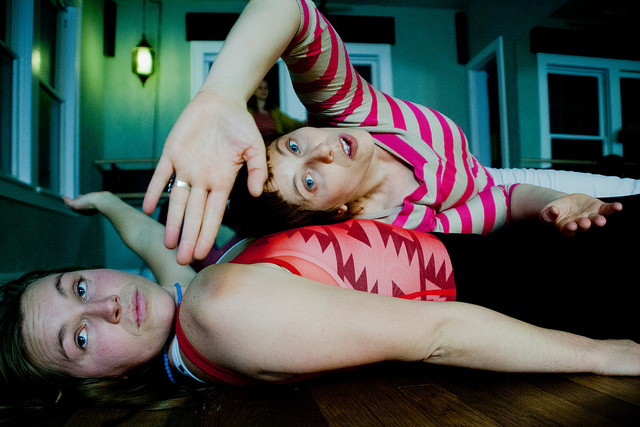The Shift Happens In The Body.
After feeding breakfast to the tween and the two teens, I dress in ratty sweatpants and t-shirt, braid my greying hair into two pigtails, and leave my ramshackle ranch house for a studio a couple of miles away.
I drift through the cool bright hallway, pay $15, and step into a big moist dark room lined with ballet barres and mirrors. A DJ bops in the far corner. Loud music thrums. All over the room, people sway, jump and canter, roll and stretch.
I put my things in a cubby and lie on my back, wave my arms and legs around, hike my hips up into the air, make spirals with my legs and toes, crack all the crick-cracks out. I shake, shimmy, roll and wave through a few yoga poses. No muscles, just bones.
A man sidles up. He’s a little older than me, expressive eyebrows, biking shorts, balding, tall and lean. He lays his back along mine. I stand there like a deer in the forest, eyes wide in the darkness, attuning. We begin to move, following a point of connection where our bodies meet.
He leans away from me; I follow and my center of gravity pours into his. Easily he lifts me, look ma no hands, just pops me up into the air on his back and I roll across. Reaching for the floor with one foot and away with the other, I touch down, a handful of shifting sand.
For the next two hours, I lie near, on, and against other bodies. We drip sweat on each other, climb up one another, slide down, flip off, twirl, grasp, nuzzle, snuggle, stumble, laugh, perch, hug, part ways, move solo for a while to shake the residue of that linking-in, find another body to move with.
I let my vision go blank and unfocused, awakening some sixth sense that lets me follow the pulsating center, the belly, the hara, the hips and pelvic bowl. My skin and the flesh beneath it become like a cat’s whiskers, like the cells on an octopus or a chameleon that change color to match its surroundings. It’s a homing instinct, a honing-in. We don’t look into each other’s eyes much, aside from saying thank you when the dance is done.
Another man: tall, muscular, bearish, boyish, fortyish, beautiful shoulders, back and neck, skilled fingers, a swelling of joy in the way he grabs me. He spirits my dense 140-pound frame into the air. Aloft, I hold myself not stiffly, but with some strength, moving my energy toward the other body’s central pole.
Another man: smaller, vulnerable, sixtyish, rolling around on the floor, making small dramatic pastiches with our bodies. With him, I feel tended to, sweet, relaxed. The next man likes to get me balanced on top of him and then cut into a serious boogie. Our joint deftness makes us both laugh, exhilarated.
Now, a woman, someone I know well. We shimmy up against each other, jump around, laugh, take turns perching on the ledge of one another’s sacrums. We finish, spooning. “Mommy!” I say, in a high-pitched, whiny voice, because I’ve had a hard week, and we start laughing. She, my mother; I, her mother; each our own mothers; belly to back, whooping, rocking, cuddling.
Forehead to forehead, hip to belly, ankle to hand, back to hips, aloft, pressed into the floor. This practice is intensely intimate; wordless; arousing; deeply sexual; non-sexual; satisfying; playful; disturbing; medicinal; shamanic. We charge each other up; we recharge. Emotions grip me, work me over, yield.
I play out movement dramas with strangers and acquaintances, evidenced by certain gestural moments that ring true across cultures and continents: a hand cradling another’s face: I love you; a mouth resting against the gap between another’s collarbones: I feel your grief; a sure resting of the pelvic symphysis against another’s broad sacrum: I want you; an ear to another’s belly: I hear you; a sweeping of one off her feet and onto the shoulder, back, or upper chest of another: I’ve got you; a set of ribs rolling across another set of ribs: breathe with me; a slow roll across the floor over one another, taking turns dropping our full weight into the other person’s torso and hips, taking care to avoid rolling across delicate joints or long locks of hair: Rest in me.
Aside from the direct, cuddle-related physical benefits of one body rolling with, pulling on, and gyrating with another, there is the benefit that comes with the dramas played out on the dance floor. I bring my personas to dance those dramas: The Vixen, The People-Pleaser, The One Who Only Feels Real When She’s Watched are a few. It’s a non-verbal laboratory where I get to watch myself play out these roles and maybe challenge their impulses once in a while.
And there is laughter. We play tag, jump up and down in a big circle, scream, make faces, sing along with the music, act out broad physical comedy.
It’s also a good place to have a cry. Touching into a place in the body where sadness or grief is held, you can collapse onto the floor and weep openly, and no one asks you what’s wrong or if you’re okay. They surround you, touch your feet, put a cheek to your forehead, smooth your hair, put a hand to the center of your chest.
~~~
I’ve been attending a psychotherapy group. As we work to iron out our self-destructive or undermining patterns, I find one thread that I can’t seem reconcile with an actual healing trajectory. It’s that we are all sitting there talking. We are telling stories about ourselves over and over again, working them over, turning them upside down and beating them on the rocks. And sometimes I think our heads don’t have the answers. The stories keep us pinned down.
The shift happens in the body. Or, at least, with the body. It happens with chucking the stories out of the f*cking window and asking ourselves, “What do we have to work with now?” This body. What it feels and senses. What emotional colors bind it and suffuse it. What choices we have in this moment.
~~~
During my 25 years as a contemporary dancer, I trained in tricks and techniques of contact improvisation. Contact dance training helps choreographers learn to work with dancers to invent duets, trios and other groupings.
Contact improvisation has become my go-to psycho-somatic therapy. As long as the people I dance with know what they’re doing—as long as I know they won’t drop or break me—I come away from each exchange feeling physically, spiritually and emotionally nourished.
To some, the frank sensuality of contact dance can feel traumatizing or invasive—even just as an observer. It isn’t for everyone. But if you are intrigued, begin by learning the basics.
There are only three real rules for doing the kind of contact dance I’m referencing, aside from the obvious rules, the same ones you’d follow if you were getting a lap dance. Try these things on with a friend or just imagine your body doing these things with another body.
- Follow the energy. Feel the small bubble of energy at the point of contact between you and another person. If both of you lean into that point, let it sit still and breathe, it will start to move. Follow it. Marvel at the way it moves outside of anyone’s choice to move it—like a Ouija board with multiple hands resting on the pointer piece. When you lose track of it, pause, find it again, and wait for it to move again. After some practice and experience, you may find that one person’s energy will take over and be more directive of both your bodies, but it takes time to feel into that.
- Give your weight completely. Lean in; find the point of contact. Wait to feel the other yielding away from you, then follow, continuing to press gently into the point of contact, giving your weight only as it feels supported. Try this back-to-back: one person pushes and the other yields until the weight of one leans fully on the weight of the other. Come back through the center and let the other person push while the other yields.
- Only give your full weight on certain parts of others’ bodies. Avoid putting weight on someone’s extremities, head, neck, soft belly parts, or upper back. Experiment at a very slow pace with places that support weight with ease. The sacrum, the very lowest back, is a good starting place. If one person stands with knees bent and bends over or gets down on all fours, the other person should be able to sit down on that person’s sacrum with all her weight. Try sitting on someone’s hip when he lies on his side. Sling the other person across your hip. Marvel at how good it feels to have someone sit or lie on top of you without all the pressure and mess of sex.
Be mindful of your breath, communicate with your dance partners, and go slow until the way feels smooth and safe:
Want to play? Google “contact improvisation” plus the name of your city. Show up. Have a glass of wine first if the whole thing makes you nervous. Don’t scam on anyone in a sexual way, and if you think someone is doing so with you, walk away—unless that’s what you are looking for, in which case, both of you can take it out of the studio and into the cold, cold world.
Relephant:
Improv Works as Well with People Who Have Alzheimer’s as It Does With Children.
.
Author: Melissa Lowenstein
Editor: Travis May
Photo: Flickr/Charlie Llewllin



Read 0 comments and reply